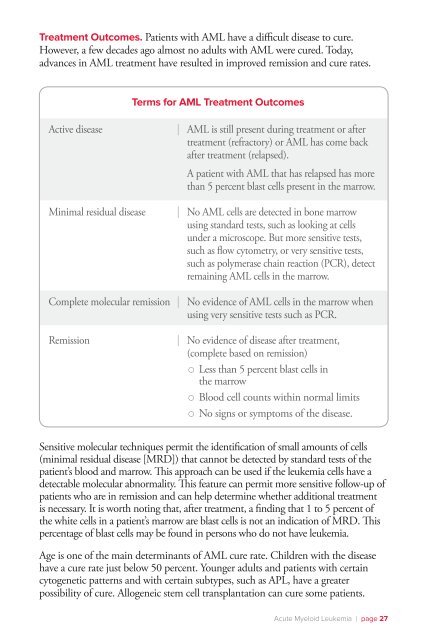Acute Myeloid Leukemia - The Leukemia & Lymphoma Society
Acute Myeloid Leukemia - The Leukemia & Lymphoma Society
Acute Myeloid Leukemia - The Leukemia & Lymphoma Society
- No tags were found...
Create successful ePaper yourself
Turn your PDF publications into a flip-book with our unique Google optimized e-Paper software.
Treatment Outcomes. Patients with AML have a difficult disease to cure.However, a few decades ago almost no adults with AML were cured. Today,advances in AML treatment have resulted in improved remission and cure rates.Terms for AML Treatment OutcomesActive diseaseMinimal residual diseaseI AML is still present during treatment or aftertreatment (refractory) or AML has come backafter treatment (relapsed).A patient with AML that has relapsed has morethan 5 percent blast cells present in the marrow.I No AML cells are detected in bone marrowusing standard tests, such as looking at cellsunder a microscope. But more sensitive tests,such as flow cytometry, or very sensitive tests,such as polymerase chain reaction (PCR), detectremaining AML cells in the marrow.Complete molecular remission I No evidence of AML cells in the marrow whenusing very sensitive tests such as PCR.RemissionI No evidence of disease after treatment,(complete based on remission)◦{Less than 5 percent blast cells inthe marrow◦{Blood cell counts within normal limits◦{No signs or symptoms of the disease.Sensitive molecular techniques permit the identification of small amounts of cells(minimal residual disease [MRD]) that cannot be detected by standard tests of thepatient’s blood and marrow. This approach can be used if the leukemia cells have adetectable molecular abnormality. This feature can permit more sensitive follow-up ofpatients who are in remission and can help determine whether additional treatmentis necessary. It is worth noting that, after treatment, a finding that 1 to 5 percent ofthe white cells in a patient’s marrow are blast cells is not an indication of MRD. Thispercentage of blast cells may be found in persons who do not have leukemia.Age is one of the main determinants of AML cure rate. Children with the diseasehave a cure rate just below 50 percent. Younger adults and patients with certaincytogenetic patterns and with certain subtypes, such as APL, have a greaterpossibility of cure. Allogeneic stem cell transplantation can cure some patients.<strong>Acute</strong> <strong>Myeloid</strong> <strong>Leukemia</strong> I page 27
















